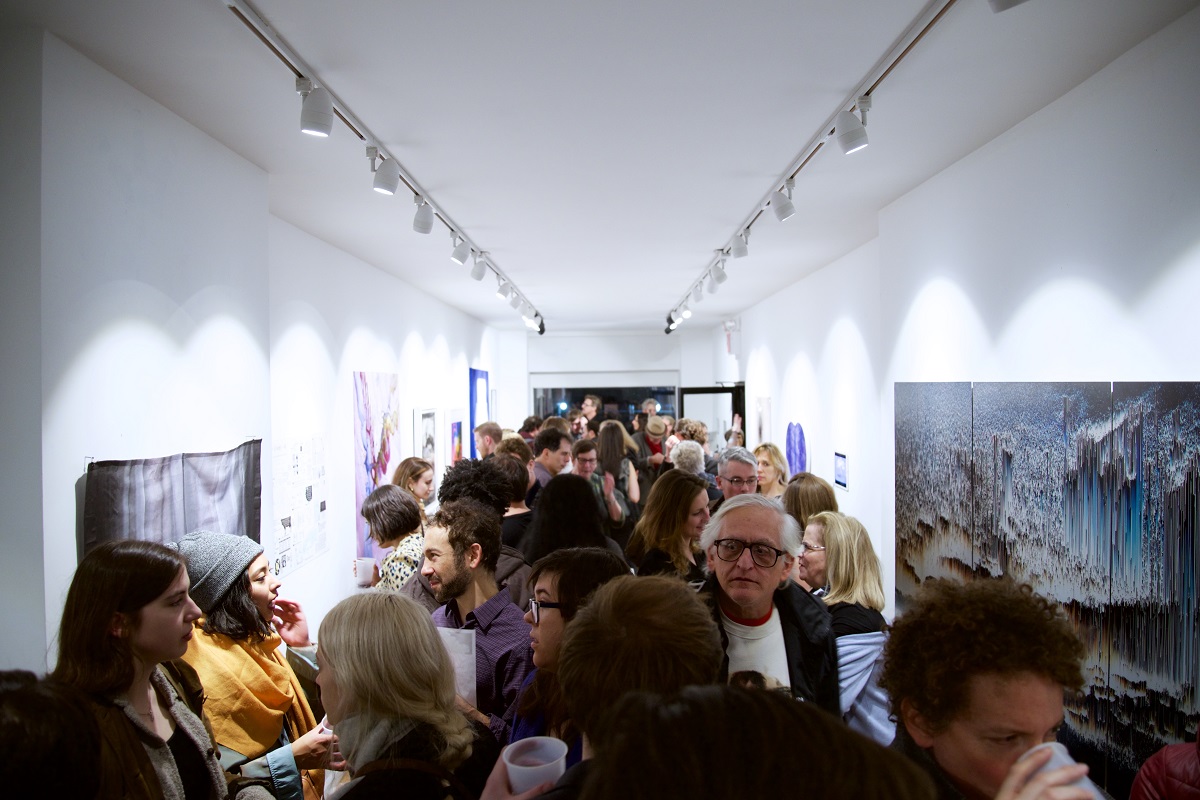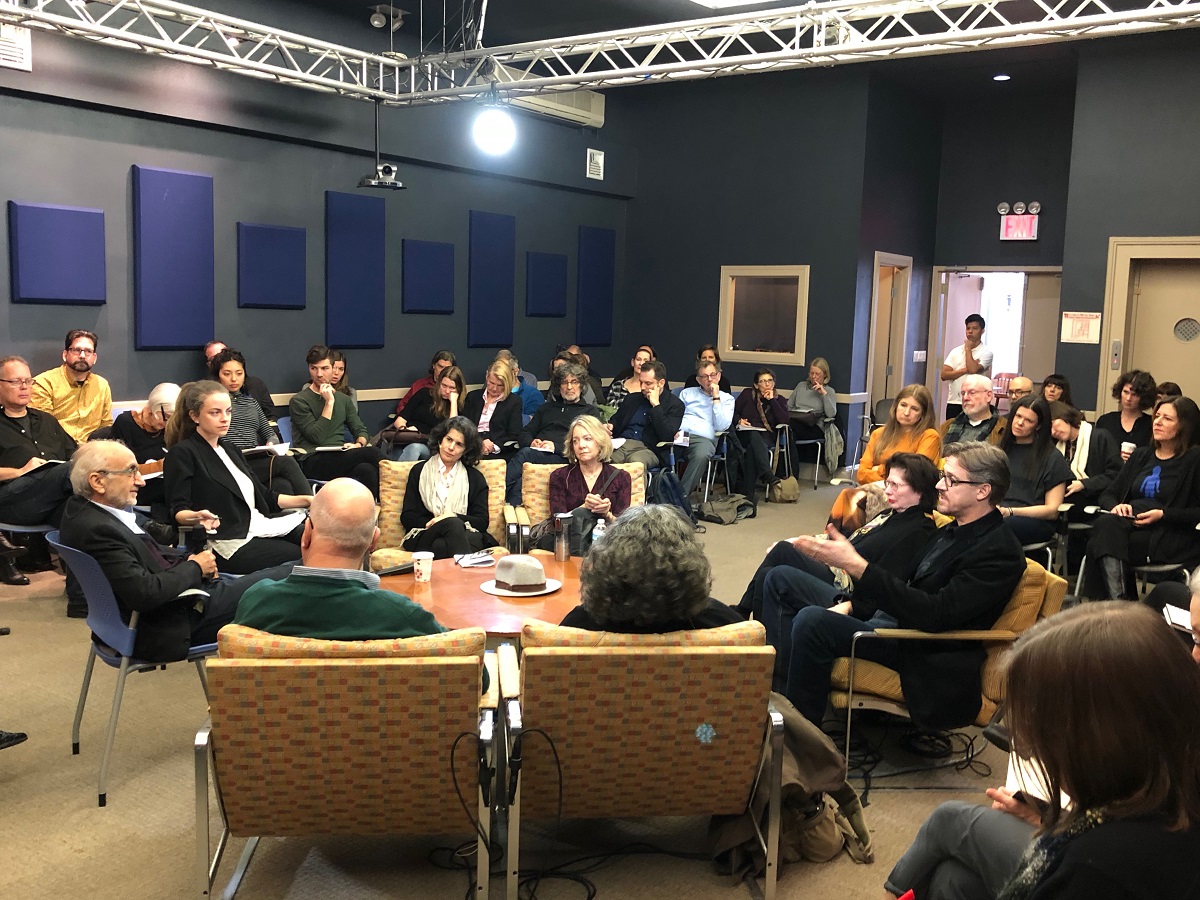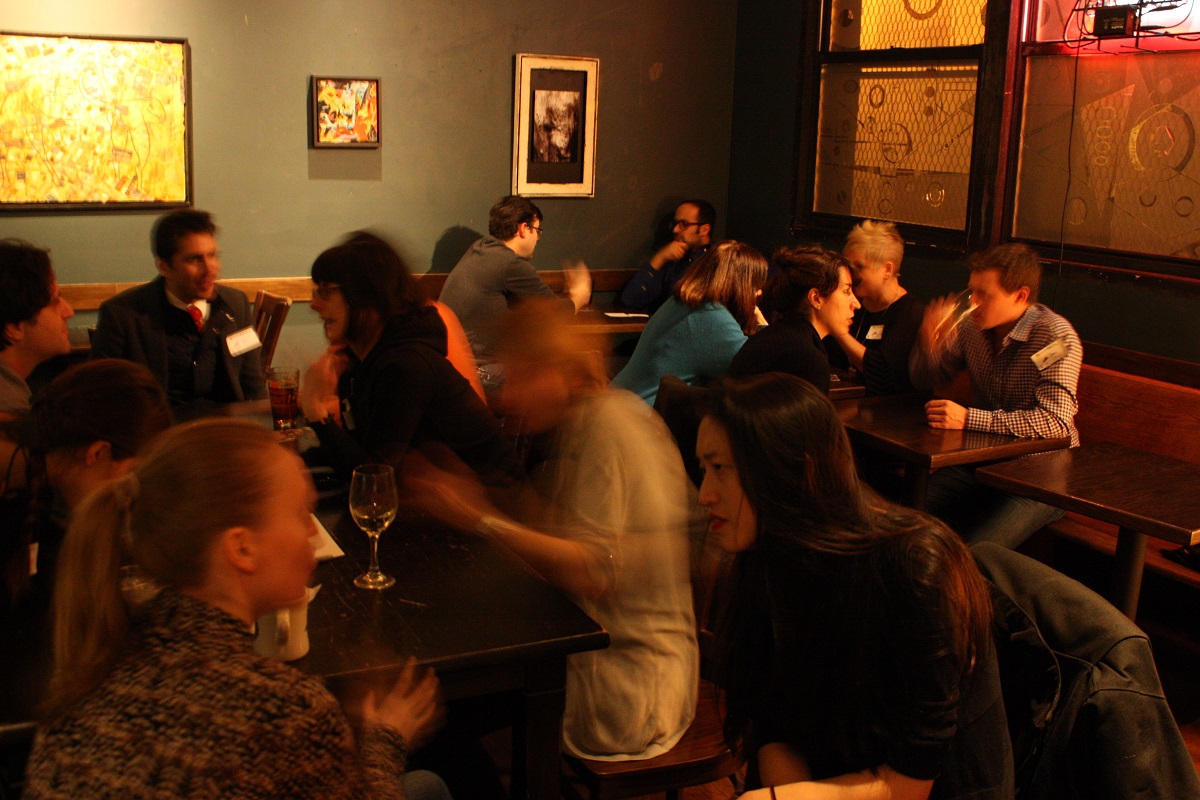If you’re passionate about both science and art — and perhaps searching for like-minded souls — an organization in New York City has your back: Founded in 2014 by neuroscience-based artist Julia Buntaine, the SciArt Center offers local and virtual events, a digital magazine, and more, all with the goal of bringing together artists and scientists worldwide.

Opening reception of pop-up exhibit of “The Void and the Cloud,” The Urban Foundation Gallery, New York, 2017. All images courtesy of Julia Buntaine.
The center has grown since its founding, Buntaine said, adding events such as a new conference held earlier this month in partnership with nonprofit The Helix Center. It also offers a microgrant program for its members, as well as a residency option that pairs artists and scientists for a four-month virtual collaboration.
Meanwhile, these programs are on top of exhibits showcasing all types of art- and science-based work — with an emphasis on the “virtual” to reach everyone interested, wherever they may be.
Buntaine, who is also an adjunct professor, recently shared her thoughts by email on the SciArt Center and the field of science-based art in general. Read on (for a lightly edited/condensed version of our interview) to learn more about the center and her interesting take on all things sciart.
Sparked: Why did you decide to start the SciArt Center? What are your goals for it?
Buntaine: The SciArt Center was founded in 2014 and was very much an extensional growth of SciArt Magazine, which I started in 2013.
While the magazine was founded with the mission to bolster and celebrate contemporary artists who are engaging deeply with science and technology, the center has extended the mission to bridging the gulf between science and art in our culture at large through events, art shows, and a grant and residency program. Each of our programs has different, specific goals, but overall we’re interested in fostering cross-disciplinary activity by bringing together artists and scientists for a common cause.
One important aspect of our programming is that it is designed to span the local/physical to the global/virtual — we try to reach our local New York audience as much as those doing science-art work in Perth, London, Toronto, Rio de Janeiro, etc., because science-art activity is truly a worldwide movement. This is why our publication is digital, and our membership is international.
And by live-streaming our events, hosting digital versions of physical exhibits, and making our residency program virtual, for example, we’re able connect pockets of science-art activity worldwide, and emphasize the importance of innovative work and ideas over geographical location.
How many exhibits are online versus in a physical location?
Most of our art shows start as a virtual exhibition, which is then translated into a physical pop-up show. These shows, which we do twice a year, operate in an open-call format and include artists from all over the world. The theme is chosen and developed by our curator, Marnie Benney, and myself and tends to address something very topical — like water or our digital lives.
Is “Two Cultures Converging” a new annual conference?
“Art & Science: The Two Cultures Converging” took place December 1-3 in Manhattan, as a partnership between the SciArt Center and The Helix Center. While it’s too early to announce officially of any sort of “annual” status, I think that’s a distinct possibility, as the conference was a success in the ways I hoped it would be.

Panel discussion at “Art & Science: The Two Cultures Converging” conference, The Helix Center, New York, 2017.
I thought of the idea for the conference about a year and half ago and designed it such that it was a conference of conversation, rather than presentation — with the hopes that an evolving dialogue would emerge over the course of three days, covering a few main topics under the science-art umbrella. It was very well-attended, and many tuned into the live stream as well, which to me indicates a growing and sustained interest in this cross-disciplinary conversation.
You’re not the first to ask about an annual happening, so stay tuned!
It seems as though interest in science-based art has grown in recent years. What do you see as driving the interest?
Artists have always responded to what is culturally central — it used to be religion, often it’s war, and lately it’s been social justice — but science has been consistently at the center of culture since about 2003. In 2003 we completed the mapping of the human genome, and this was one of the first modern examples, perhaps since the invention of the internet in the mid-90s, of the importance of a scientific advance reaching beyond the ivory tower or industry and deeply impacting the public.
We’re always talking about “they” — we’re always talking about what scientists are discovering.
Many scientific disciplines have entered the public eye since then — people outside of science know what the Large Hadron Collider is, or that the frontal lobe is an important part of the human brain, or that our coral reefs are dying, for example. This is highly scientific knowledge that became cultural, in part due to the internet and availability of information, in part due to the beautiful images that science can now produce and dazzle our eyes and imaginations with, and in part due to television, movies, and science-fiction books.
That visual (and other) artists are increasingly responding to the presence of science in everyday culture is no surprise: How many times a day do you hear the word “they” in a context like “They say coffee actually extends lifespan!”? We’re always talking about “they” — we’re always talking about what scientists are discovering.
How do you see the field developing in the future? Any particular trends?
The future of sciart as a movement is full of potential; this is part of what we talked about at the conference. There are many aspects to this movement — science-based art, STEAM education, and science-art collaboration to name the main ones — and each has its own trajectory.
Within science-based art, a number of artists have been turning their attention to our climate, and I expect that will continue to be true for a while. There is also a rising trend in art about the integration of the human body with technology — the cyborg becoming a reality. While the funding landscape for science-based art is still sparse, it is getting better thanks to scientific organizations like the Sloan Foundation and the science outreach branch of the National Science Foundation.

Suzanne Anker speaking at the SciArt Center residency program “The Bridge” symposium, School of Visual Arts, 2015.
STEAM education is still in its “buzzword” phase — that’s not to say there isn’t good, solid STEAM work being done, but it’s still very new and has many hurdles to overcome in order to become a mainstream educational model. Many institutions have started programs to impart some well-roundedness to their students, while maintaining their basic educational structure, which is a very good start. The trick is to find a way at each institution to integrate STEAM thinking: It could be one class, it could be an entire curriculum. But most often it requires hiring a new person to accomplish this, someone who can navigate an art studio as easily as a biology lab, and who can naturally impart the idea of “equal value” of art and science to students as a worldview they can carry forward.
And science-art collaboration — having artists on scientific projects and bringing scientists in to co-create art projects — is a valuable relationship that many in academia and industry are actively partaking in. As innovative work (art or science) is increasingly done by teams rather than individuals as a means to incorporate multiple skillsets and points of view, what collaboration is and can be is being defined, and expanded, as we speak.
Do you have any favorite aspects of the center or its events?
Our conference was a big step for us and truly an amazing experience, so that is definitely a contender. But in terms of already recurring programs, our residency is my favorite because it very much encapsulates what we’re about: bringing artists and scientists together.
We create pairs of artists and scientists, based on fitness through an open-call application system, who embark on a four-month-long collaboration of their own devising. We have no rules and no expectations in our program, thus each team’s collaboration is truly a product of their natural synergy. It is a virtual residency in that instead of physical space, our teams have blog space in which they record and share their collaborative process on a weekly basis. The pairs rarely live in the same place, which furthers our mission of not letting geographical location get in the way of like-minded people connecting and working together — this year two of our four teams span countries.
There is a prevalent idea out there that collaboration has to result in an end product, and I am out to dispel that notion.
The results of the collaborations vary greatly — not so much in quality, but very much in form — and this is something we encourage. There is a prevalent idea out there that collaboration has to result in an end product, and I am out to dispel that notion. I think the valuable aspect of collaboration is in the process: The experience of a successful, functional collaboration sticks with you for a lifetime, lasting far beyond the shelf-life of any tangible end product. In our postresidency testimonials, the experience is what has largely been emphasized by most of our residents.
We’ll be opening up the application process for our next round in June.
What’s next? Are there any areas you’re looking to expand into?
Our latest virtual exhibit, “SUBMERGED,” will turn into a pop-up show sometime in the spring of 2018 in New York City, and for our next curated theme, we’re likely going to be partnering with an institution in the U.K. for a virtual and multicity pop-up exhibit, with a thematic focus on stem cell science. We’re also currently partnering with the Ontario Science Centre to mount a virtual exhibition of a physical exhibit they are hosting in February on the themes of technology and interactive art.
How can people get involved and support the center’s work?
We’re a membership- and subscription-based organization and are entirely funded this way. So supporting us is easy: Join as a member or become a subscriber! Tell your friends about us! Follow us on social media! Our membership program has a variety of different perks that benefit both those near and far — and we’re always tweaking it to make it better.
